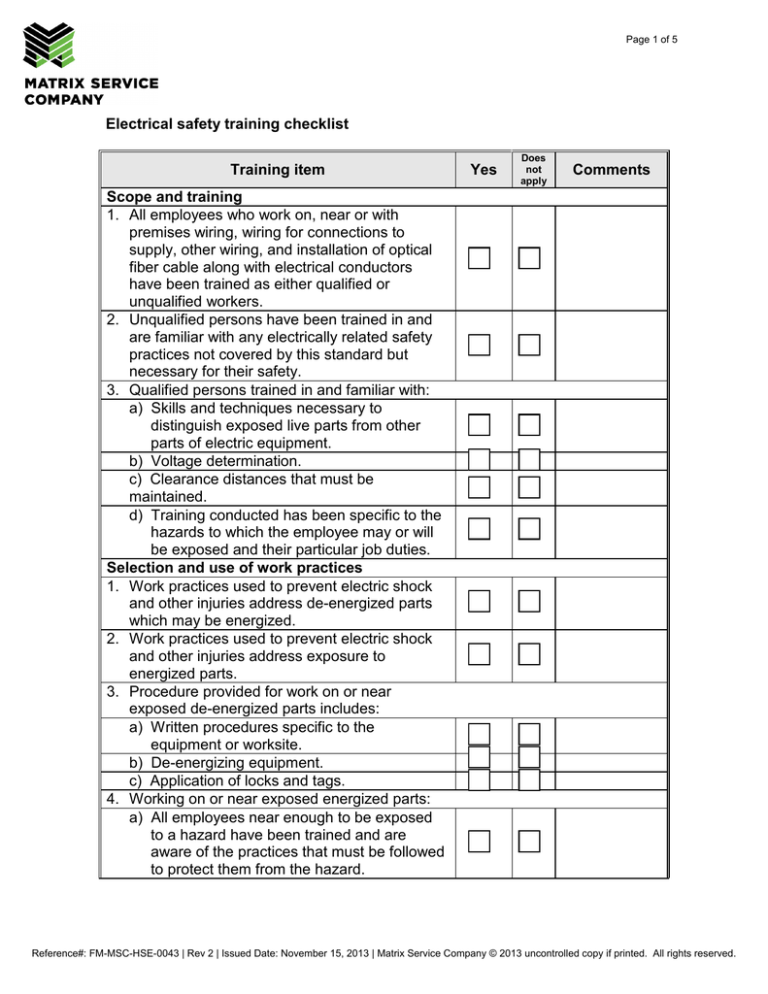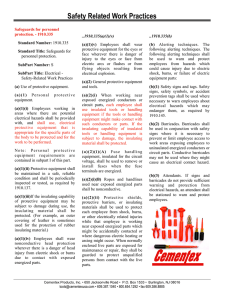
Page 1 of 5
Electrical safety training checklist
Training item
Scope and training
1. All employees who work on, near or with
premises wiring, wiring for connections to
supply, other wiring, and installation of optical
fiber cable along with electrical conductors
have been trained as either qualified or
unqualified workers.
2. Unqualified persons have been trained in and
are familiar with any electrically related safety
practices not covered by this standard but
necessary for their safety.
3. Qualified persons trained in and familiar with:
a) Skills and techniques necessary to
distinguish exposed live parts from other
parts of electric equipment.
b) Voltage determination.
c) Clearance distances that must be
maintained.
d) Training conducted has been specific to the
hazards to which the employee may or will
be exposed and their particular job duties.
Selection and use of work practices
1. Work practices used to prevent electric shock
and other injuries address de-energized parts
which may be energized.
2. Work practices used to prevent electric shock
and other injuries address exposure to
energized parts.
3. Procedure provided for work on or near
exposed de-energized parts includes:
a) Written procedures specific to the
equipment or worksite.
b) De-energizing equipment.
c) Application of locks and tags.
4. Working on or near exposed energized parts:
a) All employees near enough to be exposed
to a hazard have been trained and are
aware of the practices that must be followed
to protect them from the hazard.
Yes
Does
not
apply
Comments
Reference#: FM-MSC-HSE-0043 | Rev 2 | Issued Date: November 15, 2013 | Matrix Service Company © 2013 uncontrolled copy if printed. All rights reserved.
Page 2 of 5
Training item
b) Only qualified employees work on energized
parts.
c) Overhead lines de-energized and grounded
prior to working near them or other
protective measures used.
d) Unqualified persons working near overhead
lines are aware that they may not approach
or use conductive objects closer than 10 feet
for lines up to 50 kV or 10 feet plus 4 inches
for every 10 kV over 50 kV.
e) Qualified persons have a working
knowledge of the allowable approach
distances shown in Table S-2 of this
program.
f) Vehicle and mechanical equipment
operators understand that they must
maintain:
i) A clear distance of 10 feet plus 4
inches for every 10 kV over 50 kV while
working near energized overhead lines.
ii) A clear distance of 4 feet plus 4
inches for every 10 kV over 50 kV while in
transit.
iii) Insulating barriers are used and
installed as required.
iv) Insulated aerial lift operated by a
qualified person must comply with the
distances shown in Table S-2.
v) Employees standing on the ground
understand they may not contact the vehicle
unless using protective equipment rated for
the voltage or the equipment located so no
un-insulated part can provide a conductive
path to persons on the ground.
g) Illumination is provided at all worksites to
assure safe work.
h) Protective shields and barriers provided and
used for work in confined spaces to prevent
contact with exposed energized parts.
i) All conductive materials such as pipes, rods,
etc. are handled so as to prevent contact
with exposed energized parts.
Yes
Does
not
apply
Comments
Reference#: FM-MSC-HSE-0043 | Rev 2 | Issued Date: November 15, 2013 | Matrix Service Company © 2013 uncontrolled copy if printed. All rights reserved.
Page 3 of 5
Training item
1.
1.
2.
3.
j) Conductive articles of clothing and jewelry
such as watches, rings, etc. are not worn if
they might contact exposed energized parts
unless rendered nonconductive.
k) Portable ladders with nonconductive side
rails are used when working near or on
exposed energized conductors.
l) Housekeeping conducted only when
exposed energized parts may not be
contacted. Barriers provided and
nonconductive cleaning materials used.
m) Only qualified persons allowed to defeat
electrical interlocks on temporary basis while
they work on equipment.
Use of equipment
Portable electric equipment such as cord-andplug connected equipment, including flexible
cords:
a) Handled in a manner to avoid damage.
b) Not used to raise or lower equipment.
c) Not fastened with staples or hung so as to
damage insulation.
d) Visually inspected before each use on each
shift.
e) Defective items removed from service and
not used until rendered safe.
f) Plugs and receptacles mate properly.
g) Flexible grounding-type cords have a
grounding conductor.
h) Grounding plug not defeated.
i) Adapters which interrupt grounding
continuity not used.
j) Approved equipment used for work in
conductive work locations (e.g. wet
locations, etc.).
k) Locking-type connectors are properly
secured after connection.
Electric power and lighting circuits
Only load rated switches or circuit breakers
used as disconnecting means.
Circuits not manually re-energized until it is
determined that it is safe to do so.
Over current protection of circuits not modified.
Yes
Does
not
apply
Comments
Reference#: FM-MSC-HSE-0043 | Rev 2 | Issued Date: November 15, 2013 | Matrix Service Company © 2013 uncontrolled copy if printed. All rights reserved.
Page 4 of 5
Training item
Test instruments and equipment
1. Used by qualified persons only.
2. Visually inspected before use.
3. If circuit tested is over 600 volts nominal, test
instrument tested for proper operation before
and immediately after the test.
4. Test instrument rated for the circuit to be tested
and appropriate for the environment.
5. Electrical equipment capable of igniting
flammable or combustible materials not used if
present in the worksite.
Safeguards for personnel protection
1. Protective equipment used when there is
exposure to potential electrical hazards.
2. Protective equipment maintained in safe and
reliable condition and tested and inspected as
required.
3. Protective equipment protected from damage
during use.
4. Approved electrically rated hardhats used as
needed to protect head from electric shock or
burns.
5. Safety glasses or goggles used as needed to
protect eyes or face when there is a danger of
arcs, flashes or flying objects.
6. Approved gloves worn that are appropriate for
the hazard present
7. Insulated tools or handling equipment used
when conductors may be contacted.
8. Insulated fuse handling equipment used to
remove or install fuses when terminals are
energized.
9. Ropes and hand lines used near energized
parts are nonconductive and are protected from
moisture.
10. Protective shields, barriers or insulating
materials are used to protect employees
working near exposed energized parts.
Alerting techniques
1. Safety signs and tags used when necessary to
warn employees about electrical hazards.
Yes
Does
not
apply
Comments
Reference#: FM-MSC-HSE-0043 | Rev 2 | Issued Date: November 15, 2013 | Matrix Service Company © 2013 uncontrolled copy if printed. All rights reserved.
Page 5 of 5
Training item
2. Barricades used with safety signs when
necessary to prevent or limit employee access
to work areas with uninsulated energized
conductors or parts.
3. Attendants stationed as needed to warn when
signs or barricades are not sufficient to prevent
unauthorized access.
Name of trainer:
Employee name
Employee name
Yes
Does
not
apply
Comments
Date:
Employee name
Reference#: FM-MSC-HSE-0043 | Rev 2 | Issued Date: November 15, 2013 | Matrix Service Company © 2013 uncontrolled copy if printed. All rights reserved.


